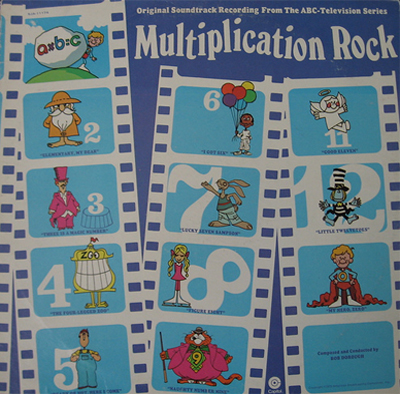MULTIPLICATION ROCK- CAPITOL 1973
BOB DOROUGH,GRADY TATE &BLOSSOM DEARIE
In honor of our 3rd post i’m dropping this lil’ gem , featuring the song “3 is the magic number” by Bob Dorough…which was quite famously sampled by De La Soul on their track of the same name on the album “3 Feet High And Rising”. Let me just begin by saying, I LOVE THIS RECORD!!! I spent the better part of a decade looking for this record after hearing that De La song. (mostly due to my aversion to paying eBay prices for records.) Lo and behold one grey and rainy Sunday afternoon at the flea market on Terminal Ave. in Vancouver, British Columbia. Circa the mid 90’s…I see the top inch of this sought after little nugget of sampling bliss sticking out of a milkcrate of $1 kids records…hiding my glee, I quickly grab 4 other records from the same crate (as if to disguise my find?) and walk calmly to the cash pay the man 5 whole dollars and quietly turned towards the door making my exit…i swung the doors open to reveal the shining sun and birds chirping, holding the records skyward i let out i triumphant “FUCK YEAH!!!!!!” . It was as tho the whole world had flipped on it’s axis and things were looking up for me, a sweet find, the sun had come back out and all was well. Looking around, I quickly realized that everyone within 50 feet was staring at me like a sideshow freak….and i couldn’t have cared less.
Multiplication Rock is one part of a 6 part series of animated musical educational short films that aired during the Saturday morning children’s programming on the U.S. television network ABC. The topics covered included grammar, science, economics, history, mathematics, and civics. The series produced original episodes between 1973 and 1986 (with 37 episodes created between 1973 and 1980, and four created as the “Computer Rock” segment between 1983 and 1984), with a return in 1993 and new episodes airing at least once a year between then and 1996, when production of the series for ABC was halted. Episodes continued to air for an additional five years after that, finally coming to an end after a 26-year run cancellation in 1999 by ABC.
Schoolhouse Rock! began as a commercial advertising venture by David McCall. The idea came to McCall when he noticed one of his sons, who was having trouble in school remembering the multiplication tables, knew the lyrics to many current rock songs. The first song recorded was “Three Is a Magic Number,” written by Bob Dorough. It tested well, so a children’s record was compiled and released. Tom Yohe listened to the first song, and began to doodle pictures to go with the lyrics. He told McCall that the songs would make good animation.
When a print workbook version fell through, McCall’s company decided to produce their own animated versions of the songs, which they then sold to ABC (which already was McCall’s company’s biggest advertising account) based on a demo animation of the original “Three Is A Magic Number” for its Saturday morning lineup. They pitched their idea to Michael Eisner, then vice-president of ABC’s children’s programming division. Eisner brought longtime Warner Bros. cartoonist/director Chuck Jones to the meeting to also listen to the presentation.
The network’s children’s programming division had producers of its regular 30- and 60-minute programs cut three minutes out of each of their shows, and sold General Foods on the idea of sponsoring the segments. The series stayed on the air for 12 years. Later sponsors of the Schoolhouse Rock! segments included Nabisco, General Foods, Kenner Toys, Kellogg’s, and McDonald’s.
The last of the original series were four segments about the then-novel personal computer technology. The shorts featured two characters by the name of Scooter Computer and Mister Chips, and so these were the only episodes in the series to feature any recurring characters.
Bob Dorough was born in arkansas in 1923, and grew up in Texas. He played in an Army band during World War II, then went to North Texas State University, where he majored in composition and minored in piano. He moved to New York City around 1950 and was playing piano in a Times Square tap dance studio when he was introduced to the boxer Sugar Ray Robinson, who had temporarily left boxing and was putting together a song and dance revue. Dorough was hired and later became the show’s music director; the revue traveled to various U.S. cities and then to Europe.
Dorough left Robinson in Paris and lived there from 1954 to 1955, recording with singer Blossom Dearie during that time. He returned to the United States and moved to Los Angeles, where he played various gigs, including a job between sets by comedian Lenny Bruce. Dorough released his first album, Devil May Care, in 1956. It contained a version of “Yardbird Suite” with lyrics by Dorough over the famous Charlie Parker song.
Trumpeter Miles Davis liked the album, so when Columbia asked Davis to record a Christmas song in 1962, Davis turned to Dorough for lyrics and singing duties. The result was a downbeat tune called “Blue Xmas,” released on Columbia’s Jingle Bell Jazz compilation. During that session Dorough recorded another song for Davis, “Nothing Like You,” which appeared a few years later at the end of the Sorcerer album, making Dorough one of the few musicians with a vocal performance on a Miles Davis record.
“Comin’ Home Baby”, written by Dorough and bassist friend Ben Tucker, was a Top 40 hit for Mel Tormé in 1962, and earned Tormé two Grammy nominations.
Dorough had a producing partnership for many years with Stu Scharf, and were best known for producing two albums for the folk/jug band Spanky and Our Gang, adding jazz-influenced arrangements to their sound. Through Tucker, Dorough was approached in the early 1970s by advertiser David McCall and asked to put multiplication tables to music. The result was “Three Is a Magic Number”, the first song for what would become Schoolhouse Rock!. Dorough remained with the show from 1973-1985.
Although he worked with Miles Davis and Allen Ginsberg, and his adventurous style was an influence on Mose Allison, among other singers. He is perhaps best known as a voice and primary composer of many of the songs used in Schoolhouse Rock!, Dorough composed, conducted and played much of the “Schoolhouse Rock!” music.
Dorough has released vocal jazz albums periodically over the last 50 years; his latest, Small Day Tomorrow, came out in 2006. He worked with Nellie McKay on her 2007 album, Obligatory Villagers as well as her 2009 release, Normal as Blueberry Pie – A Tribute to Doris Day. Bob Dorough was honored by East Stroudsburg University of Pennsylvania in December 2007 with the honorary degree of Doctor of Fine Arts. In 2005 and 2008, Circumstantial Productions published two editions of the book, BLUE XMAS, the story of Dorough’s song.
http://www.mediafire.com/?mzytmm4mnn3Get yourself a nice original copy of Multiplication Rock here or a reissue here…
OR…
ripped from vinyl @320 or better.Always.
enjoy.




